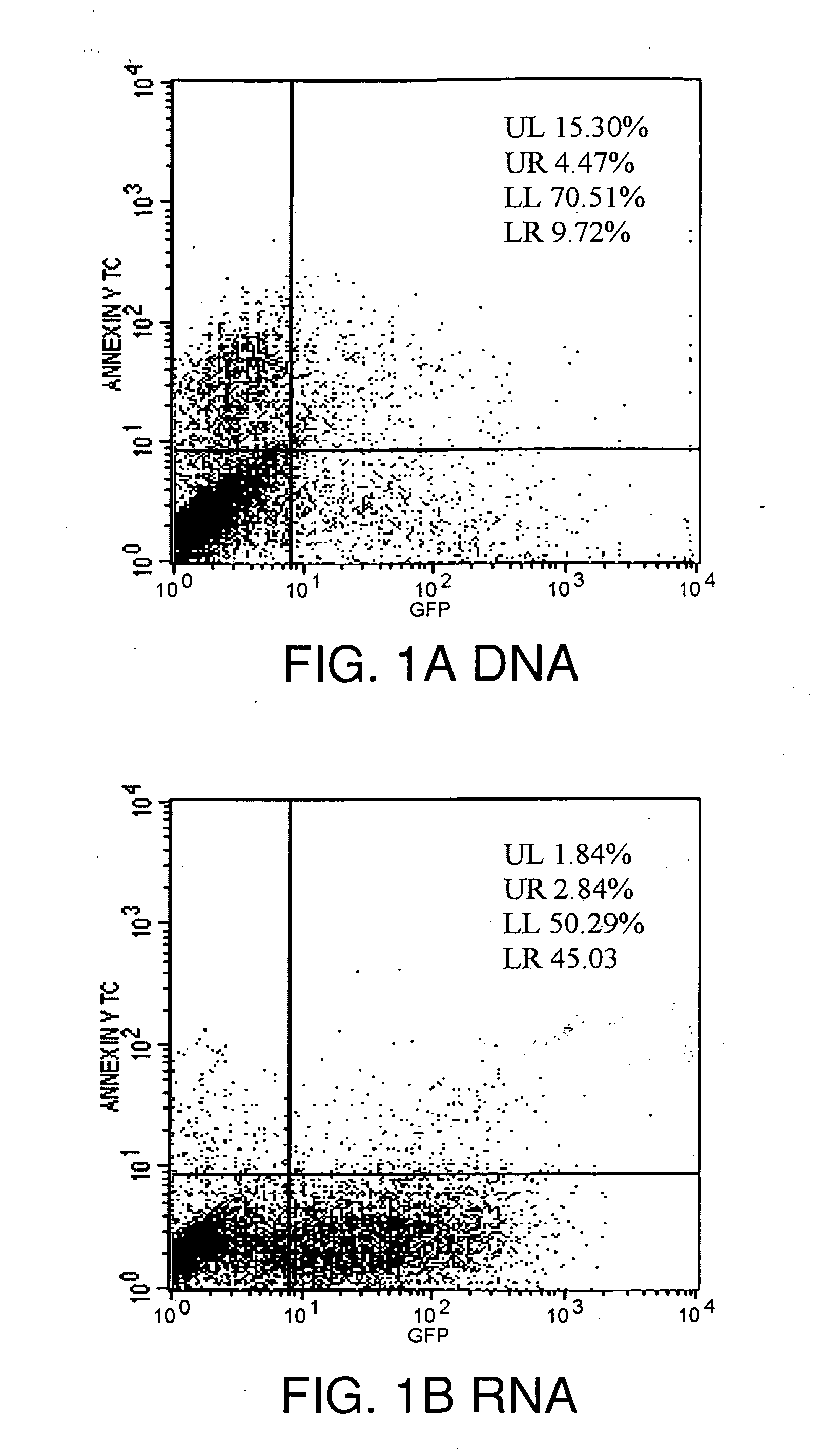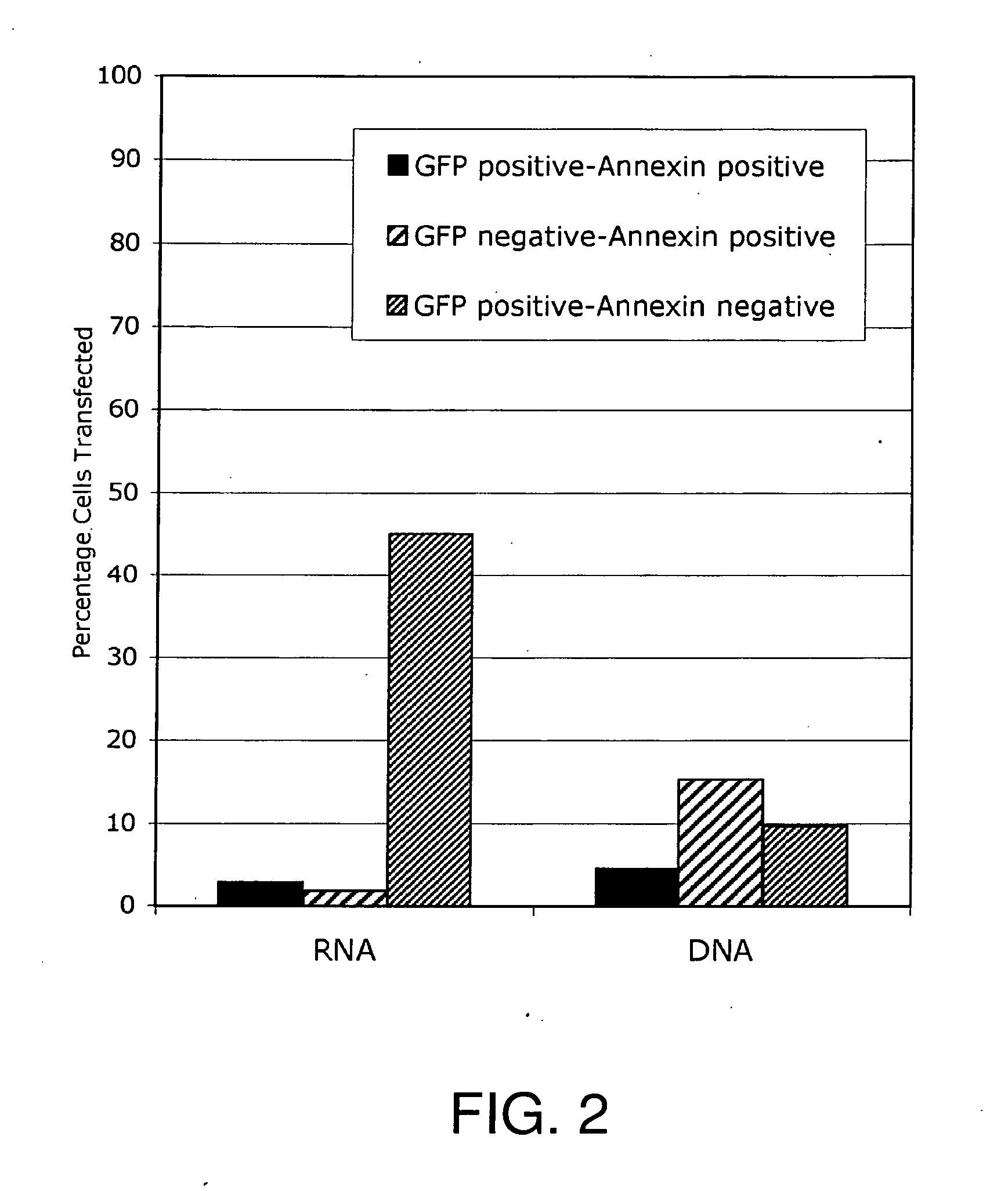Novel Methods and Models for Rapid, Widespread Delivery of Genetic Material to the CNS Using Non-Viral, Cationic Lipid-Mediated Vectors
a technology of cationic lipids and vectors, applied in the direction of genetic material ingredients, non-active genetic ingredients, drug compositions, etc., can solve the problems of risk and duration of gene, inability to prove safe in a patient, and trials that have not examined the cationic lipid delivery method of gene sequences in vivo. to achieve the effect of facilitating the transient delivery of nucleic acids
- Summary
- Abstract
- Description
- Claims
- Application Information
AI Technical Summary
Benefits of technology
Problems solved by technology
Method used
Image
Examples
example 1
Lipid-Mediated Delivery of RNA in Non-Dividing Cells is More Efficient than DNA
Materials and Methods
[0127]Cell Maintenance: Both proliferation-inhibited Chinese Hamster Ovary (CHO) cells (ATCC, Rockville, Md.) and NIH 3T3 fibroblast cells (ATCC, Rockville, Md.) were cultured in 75 cm2 cell culture flasks with media containing 10% bovine calf serum at 37° C. in a 5% CO2 environment, in HAMS F12 media (Life Technologies, Gaithersburg, Md.) or DMEM media (Life Technologies) respectively. Both CHO and NIH3T3 cells were split 24-48 hours prior to transfection and plated at 60% confluence, e.g., plated at 50,000 cells per well using 24 well plates (Falcon, Franklin Lakes, N.J.)
[0128]Primary Neuronal Cells: Primary neuronal cells were dissected from the cortex of day 17 Sprague-Dawley fetal rat brains as previously described by McKinney et al., Stroke 27:934-940 (1996). Briefly, fetal rat brains were removed and placed in ice cold sterile PBS where the cortex was dissected and cleared of m...
example 2
Method for Conjugating Aminooxy-Ligands to Pre-Formed Lipoplexes
[0153]In the example that follows, a different cationic lipid, DMDK, was formulated and shown to effectively protect plasmid DNA from degradation from DNAses or from human cerebral spinal fluid. Following preparation of a lipoplex comprising plasmid DNA encoding luciferase or GFP using the methods described above, the preparation was incubated with commercially available DNAses, or with human CSF in vitro, and then the DNA was extracted from the lipoplex. To confirm that the DNA remained intact and of an appropriate length, the samples were run on an agarose gel, or they were used in transfections to demonstrate that the protein remain functional and could still be transcribed and translated.
[0154]Preparation of DMDK
[0155]Amino Acetal: To a solution of a selected amine (1-(N-benzyl-N-methylamino)-2-propanone; 13.5 g, 76.1 mmol) in a 1:1 mixture of triethylorthoformate in ethanol (120 mL) was added p-toluenesulfonic acid...
example 3
Confirm Stabilization and Protective Effect of Congener Lipoplexed to Nucleic Acid
[0193]Although experiments in human CSF (hCSF) (Anderson et al., supra, 2003) confirmed the effectiveness of cationic, lipid-based vectors (lipoplexes) for extending the protection to mRNAs against degradation by CNS RNases using the formulation of the present invention, data was not available to characterize and quantitate the extensive distribution, uptake, and cellular expression in the CNS of a human or primate subject of reporter genes, such as GFP. No data had been reported on the effect of the nucleic acid / lipid-based vector formulation on cells, such as neurons and Hsp70, the most highly inducible and neuroprotective of the heat shock proteins.
[0194]Tests were first designed to evaluate the efficacy of neuroprotection strategies, evaluate cellular toxicity and quantify the expression of Hsp70 and other gene sequences in the CNS and various other tissues over a time course following delivery of ...
PUM
 Login to View More
Login to View More Abstract
Description
Claims
Application Information
 Login to View More
Login to View More - R&D
- Intellectual Property
- Life Sciences
- Materials
- Tech Scout
- Unparalleled Data Quality
- Higher Quality Content
- 60% Fewer Hallucinations
Browse by: Latest US Patents, China's latest patents, Technical Efficacy Thesaurus, Application Domain, Technology Topic, Popular Technical Reports.
© 2025 PatSnap. All rights reserved.Legal|Privacy policy|Modern Slavery Act Transparency Statement|Sitemap|About US| Contact US: help@patsnap.com



